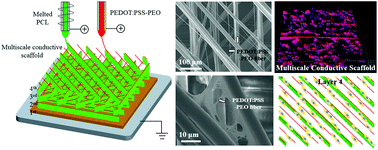Electrohydrodynamic 3D printing of layer-specifically oriented, multiscale conductive scaffolds for cardiac tissue engineering†
Abstract
Mimicking the hierarchical microarchitecture of native myocardium in vitro plays an important role in cardiac tissue engineering. Here we present a novel strategy to produce multiscale conductive scaffolds with layer-specific fiber orientations for cardiac regeneration by combining solution-based and melt-based electrohydrodynamic (EHD) printing techniques. Polycaprolactone (PCL) microfibers were printed by melt-based EHD printing and the fiber orientation was flexibly controlled in a layer-by-layer manner according to user-specific design. The as-printed microfibrous scaffolds can provide the seeded cells necessary contact cues to guide layer-specific cellular alignments. Sub-microscale conductive fibers were simultaneously incorporated inside the well-organized PCL scaffolds by solution-based EHD printing, which significantly improved the conductivity as well as the cellular adhesion and proliferation capacity. The multiscale conductive scaffolds can further direct the multiple-layer alignments of primary cardiomyocytes and facilitate cardiomyocyte-specific gene expressions, which exhibited enhanced synchronous beating behavior compared with pure microfibrous scaffolds. It is envisioned that the proposed hybrid EHD printing technique might provide a promising strategy to fabricate multifunctional micro/nanofibrous scaffolds with biomimetic architectures, electrical conductivity and even biosensing properties for the regeneration of electroactive tissues.



 Please wait while we load your content...
Please wait while we load your content...